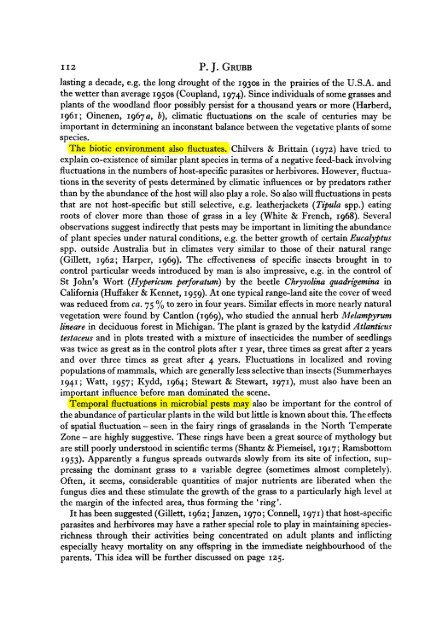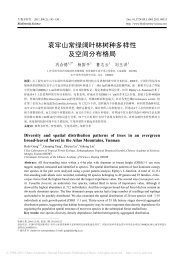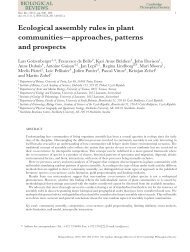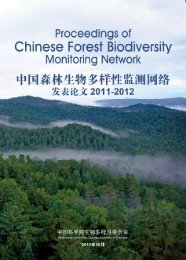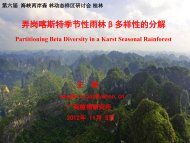the maintenance of species-richness in plant communities
the maintenance of species-richness in plant communities
the maintenance of species-richness in plant communities
You also want an ePaper? Increase the reach of your titles
YUMPU automatically turns print PDFs into web optimized ePapers that Google loves.
I12<br />
P. J. GRUBB<br />
last<strong>in</strong>g a decade, e.g. <strong>the</strong> long drought <strong>of</strong> <strong>the</strong> 1930s <strong>in</strong> <strong>the</strong> prairies <strong>of</strong> <strong>the</strong> U.S.A. and<br />
<strong>the</strong> wetter than average 1950s (Coupland, 1974). S<strong>in</strong>ce <strong>in</strong>dividuals <strong>of</strong> some grasses and<br />
<strong>plant</strong>s <strong>of</strong> <strong>the</strong> woodland door possibly persist for a thousand years or more (Harberd,<br />
1961; Ohenen, 1967a, b), climatic fluctuations on <strong>the</strong> scale <strong>of</strong> centuries may be<br />
important <strong>in</strong> determ<strong>in</strong><strong>in</strong>g an <strong>in</strong>constant balance between <strong>the</strong> vegetative, <strong>plant</strong>s <strong>of</strong> some<br />
<strong>species</strong>.<br />
The biotic environment also fluctuates. Chilvers & Britta<strong>in</strong> (1972) have tried to<br />
expla<strong>in</strong> co-existence <strong>of</strong> similar <strong>plant</strong> <strong>species</strong> <strong>in</strong> terms <strong>of</strong> a negative feed-back <strong>in</strong>volv<strong>in</strong>g<br />
fluctuations <strong>in</strong> <strong>the</strong> numbers <strong>of</strong> host-specific parasites or herbivores. However, fluctuations<br />
<strong>in</strong> <strong>the</strong> severity <strong>of</strong> pests determ<strong>in</strong>ed by climatic <strong>in</strong>fluences or by predators ra<strong>the</strong>r<br />
than by <strong>the</strong> abundance <strong>of</strong> <strong>the</strong> host will also play a role. So also will fluctuations <strong>in</strong> pests<br />
that are not host-specific but still selective, e.g. lea<strong>the</strong>rjackets (TZpula spp.) eat<strong>in</strong>g<br />
roots <strong>of</strong> clover more than those <strong>of</strong> grass <strong>in</strong> a ley (White & French, 1968). Several<br />
observations suggest <strong>in</strong>directly that pests may be important <strong>in</strong> limit<strong>in</strong>g <strong>the</strong> abundance<br />
<strong>of</strong> <strong>plant</strong> <strong>species</strong> under natural conditions, e.g. <strong>the</strong> better growth <strong>of</strong> certa<strong>in</strong> Eucalyptus<br />
spp. outside Australia but <strong>in</strong> climates very similar to those <strong>of</strong> <strong>the</strong>ir natural range<br />
(Gillett, 1962; Harper, 1969). The effectiveness <strong>of</strong> specific <strong>in</strong>sects brought <strong>in</strong> to<br />
control particular weeds <strong>in</strong>troduced by man is also impressive, e.g. <strong>in</strong> <strong>the</strong> control <strong>of</strong><br />
St John’s Wort (Hypericum perforaturn) by <strong>the</strong> beetle Chrysol<strong>in</strong>u quadrigem<strong>in</strong>a <strong>in</strong><br />
California (Huffaker & Kennet, 1959). At one typical range-land site <strong>the</strong> cover <strong>of</strong> weed<br />
was reduced from cu. 75 yo to zero <strong>in</strong> four years. Similar effects <strong>in</strong> more nearly natural<br />
vegetation were found by Cantlon (1969), who studied <strong>the</strong> annual herb Melumpymm<br />
Z<strong>in</strong>eare <strong>in</strong> deciduous forest <strong>in</strong> Michigan. The <strong>plant</strong> is grazed by <strong>the</strong> katydid Atlanticus<br />
testaceus and <strong>in</strong> plots treated with a mixture <strong>of</strong> <strong>in</strong>secticides <strong>the</strong> number <strong>of</strong> seedl<strong>in</strong>gs<br />
was twice as great as <strong>in</strong> <strong>the</strong> control plots after I year, three times as great after 2 years<br />
and over three times as great after 4 years. Fluctuations <strong>in</strong> localized and rov<strong>in</strong>g<br />
populations <strong>of</strong> mammals, which are generally less selective than <strong>in</strong>sects (Summerhayes<br />
1941 ; Watt, 1957; Kydd, 1964; Stewart & Stewart, I ~ I ) must , also have been an<br />
important <strong>in</strong>fluence before man dom<strong>in</strong>ated <strong>the</strong> scene.<br />
Temporal fluctuations <strong>in</strong> microbial pests may also be important for <strong>the</strong> control <strong>of</strong><br />
<strong>the</strong> abundance <strong>of</strong> particular <strong>plant</strong>s <strong>in</strong> <strong>the</strong> wild but little is known about this. Theeffects<br />
<strong>of</strong> spatial fluctuation - seen <strong>in</strong> <strong>the</strong> fairy r<strong>in</strong>gs <strong>of</strong> grasslands <strong>in</strong> <strong>the</strong> North Temperate<br />
Zone - are highly suggestive. These r<strong>in</strong>gs have been a great source <strong>of</strong> mythology but<br />
are still poorly understood <strong>in</strong> scientific terms (Shantz & Piemeisel, 1917; Ramsbottom<br />
1953). Apparently a fungus spreads outwards slowly from its site <strong>of</strong> <strong>in</strong>fection, suppress<strong>in</strong>g<br />
<strong>the</strong> dom<strong>in</strong>ant grass to a variable degree (sometimes almost completely).<br />
Often, it seems, considerable quantities <strong>of</strong> major nutrients are liberated when <strong>the</strong><br />
fungus dies and <strong>the</strong>se stimulate <strong>the</strong> growth <strong>of</strong> <strong>the</strong> grass to a particularly high level at<br />
<strong>the</strong> marg<strong>in</strong> <strong>of</strong> <strong>the</strong> <strong>in</strong>fected area, thus form<strong>in</strong>g <strong>the</strong> ‘r<strong>in</strong>g’.<br />
It has been suggested (Gillett, 1962; Janzen, 1970; Connell, 1971) that host-specific<br />
parasites and herbivores may have a ra<strong>the</strong>r special role to play <strong>in</strong> ma<strong>in</strong>ta<strong>in</strong><strong>in</strong>g <strong>species</strong><strong>richness</strong><br />
through <strong>the</strong>ir activities be<strong>in</strong>g concentrated on adult <strong>plant</strong>s and <strong>in</strong>flict<strong>in</strong>g<br />
especially heavy mortality on any <strong>of</strong>fspr<strong>in</strong>g <strong>in</strong> <strong>the</strong> immediate neighbourhood <strong>of</strong> <strong>the</strong><br />
parents. This idea will be fur<strong>the</strong>r discussed on page 125.


